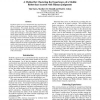Free Online Productivity Tools
i2Speak
i2Symbol
i2OCR
iTex2Img
iWeb2Print
iWeb2Shot
i2Type
iPdf2Split
iPdf2Merge
i2Bopomofo
i2Arabic
i2Style
i2Image
i2PDF
iLatex2Rtf
Sci2ools
AAAI
2000
2000
A Method for Clustering the Experiences of a Mobile Robot that Accords with Human Judgments
If robotic agents are to act autonomously they must have the ability to construct and reason about models of their physical environment. For example, planning to achieve goals requires knowledge of how the robot's actions affect the state of the world over time. The traditional approach of handcoding this knowledge is often quite difficult, especially for robotic agents with rich sensing abilities that exist in dynamic and uncertain environments. Ideally, robots would acquire knowledge of their environment and then use this knowledge to act. We present an unsupervised learning method that allows a robotic agent to identify and represent qualitatively different outcomes of actions. Experiments with a Pioneer-1 mobile robot demonstrate the utility of the approach with respect to capturing the structure and dynamics of a complex, real-world environment, and show that the models acquired by the robot correlate surprisingly well with human models of the environment.
| Added | 01 Nov 2010 |
| Updated | 01 Nov 2010 |
| Type | Conference |
| Year | 2000 |
| Where | AAAI |
| Authors | Tim Oates, Matthew D. Schmill, Paul R. Cohen |
Comments (0)

